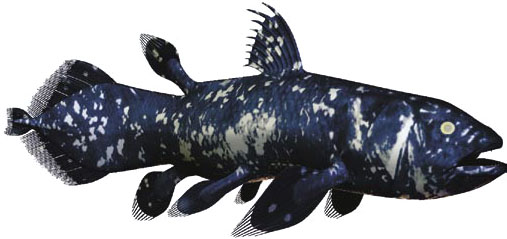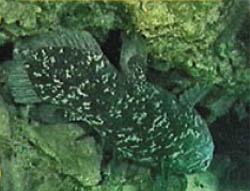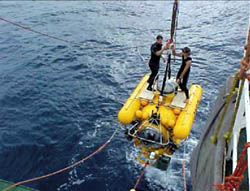|
Coelacanths, like dinosaurs,
were known only
from fossils cast in ancient
stone. Scientists believed
they been extinct for over 70
million years. Then, astonishingly,
fishermen found a
strange, blue fish - a living
coelacanth - in their nets
near East London in 1938.
This discovery shook the
scientific world.
 Illustration: Cobus Prinsloo The coelacanth made the
headlines again 14 years
later, when one was caught
in the Comoros and flown
to South Africa for study
by Professor JLB Smith.
Thereafter, a number of
these fish were caught in the
Comoros, off Mozambique
and Madagascar.
Three years ago, a group
of divers amazed the world
when they discovered coelacanths
swimming in South
Africa’s Greater St Lucia
Wetland Park at a depth
of just over 100 metres.
Nowhere else in the world
are coelacanths in such shallow
water and so accessible
to research. As a result of
this find, the South African
government launched the
Coelacanth Programme in
2002.
These unique prehistoric
creatures provide scientists
with an extraordinary window
to the past, allowing us
to look back in time. They
also unlock the door to the
future, opening opportunities
to explore the deep reefs of
the sea, and to research our
marine resources. This will
allow people who depend
upon the sea to have a better
future.
The coelacanth allows
young and old to participate
in 'living' history in an
exciting chapter of southern
African science. The
Coelacanth Programme’s
research ship is often opened
to learners and educators.
There they get information
about careers associated with
deep-sea exploration, from
being a scientist, captain of a
ship, electronics technician to
an engineer in charge of huge
engines.
The coelacanth and
biotechnology
Biotechnology plays a big
role in the studies of the
coelacanth. All the information
which coelacanths
inherit from one generation
to another is stored in their
DNA as genes.
Biotechnology is the tool to
measure all these genetic
differences of the coelacanth
DNA.
The more genetic differences
there are, the better,
as it means the coelacanth is
more likely to survive changing
conditions and new diseases.
If there is little genetic
variation, the coelacanth
could possibly be wiped out
by a new disease as it is less
likely to have the gene needed
to fight the disease.
Studying the genetics of
coelacanth populations will
answer many of our questions
regarding this fascinating
fish. It will tell us if the
South African population is
unique or similar
to those found
in other parts of
the world; if the
individuals in
South Africa are
all members of one family;
and if the population is large
enough to breed and survive.
Members of the research
team are collecting scales
from coelacanths without
disturbing or harming them.
Scales grow back rapidly to
replace those that had been
removed. Scale samples
have been collected from six
individuals to date to study
the genetics of the coelacanth.
The scales have so far
shown that the South African
group is closely related to
populations elsewhere off
Africa.
Four-limbed animals
The coelacanth is very
important to biologists
studying the evolution of
four-limbed animals (tetrapods).
Learning more about
the genome (sets of chromosomes
containing genes)
structure and biology of the
coelacanth will tell scientists
lots about the evolution of
modern day vertebrates. The
coelacanth genome may offer
a glimpse of the genomes of
creatures that evolved into
modern day tetrapods over
400 million years ago.
Biodiversity and the health of planet Earth
We need biodiversity (many different forms of life) on
Earth if we want to live here. Biodiversity shows how sick
or healthy our planet is.
There are three types of
diversity that indicate our
planet's health:
Ecosystem diversity: The
variety of environments on
Earth, made up of different
habitats. The Greater
St Lucia Wetland Park is an
example of a habitat.
Differences between species:
A species is a particular
kind of organism. There are
about one million known
animal species and over
350 000 known plant species.
All members of a species
have the same general
appearance and behaviour.
The coelacanth is an example
of a species. The members of
a species breed among themselves
and, because the same
mixture of chromosomes and
genes is passed to the new
generation, the offspring are
of the same kind.
Differences within species:
In a species, there can be lots
of variation between individuals.
If you look at your
friends, they are all slightly
different though they are all
members of the human species.
Coelacanths will all also
differ from one another.

A picture taken
during a December
2000 expedition by
Christo Serfontein,
in Jesser Canyon,
Sodwana. |

The Jago submersible is used
to study coelacanths. |
Sources: African Coelacanth Ecosystem Programme;
Public Understanding of Biotechnology Programme
|